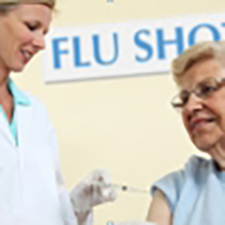New UMC study shows that influenza vaccination of workers reduces flu in patients

It has always been clear that influenza vaccination of healthy adults works very well in 70% of cases. And in nursing homes, too, it had already been demonstrated that increasing vaccination coverage leads to less mortality and pneumonia among patients. For hospitals, where patient turnover is much higher than in nursing homes, no scientific evidence had yet been provided. Until now. One of my PhD students, Josien Riphagen-Dalhuisen, is the first researcher to find that an increase in the vaccination coverage of UMC staff leads to a considerable decrease in the incidence of flu and pneumonia in patients.
Vaccination is cheaper
In addition, the investigation has shown that the cost of vaccination is lower than the cost of non-vaccination. This concerns the costs of sickness absence and longer treatment of patients who suffer from flu or pneumonia. The cost of mortality is not included.
Significant quality indicator
Based on these research results and the pilot study that we are going to carry out in all hospitals in the north of the Netherlands, I expect that the percentage of vaccinated staff in hospitals for health insurers can become an important quality indicator in health care procurement. After all, the duration of the stay will be extended in a hospital with few vaccinated staff. It is therefore not unlikely that flu vaccination will eventually become compulsory for staff, as is the case for hepatitis B. And, as far as I am concerned, rightly so, although I realise that all kinds of legal hurdles have to be overcome to this end.
Inversely proportional relationship
You can read exactly how the study was carried out and which communication and logistics strategies were used to increase vaccination coverage in the open access
by Josien Riphagen-Dalhuisen (2013). There are a few key figures I would like to share with you. The study was conducted at the eight UMCs in Internal Medicine departments. For some of the UMCs, vaccination coverage was stimulated in various ways over a period of two years. In 2009, the year of the imminent swine flu pandemic, the vaccination coverage was 60% in the intervention UMCs compared to 30% in the control group. The following year, when the pandemic turned out to be not all that bad, the vaccination coverage was 20% compared to 10%. In 2009, 10% of patients in the control group contracted influenza or pneumonia compared to 4% in the intervention UMCs. The following year, the ratio was the same. These are dramatic results!
Finally, I would like to show you a short, impressive video of how patients can contract and spread a cough virus. It is called Coughing Robot Spews 'Flu Germs'.
Prof. Eelko Hak
Tenure track professor of Clinical Pharmacology at the University of Groningen
050-3638707
e.hak@rug.nl
